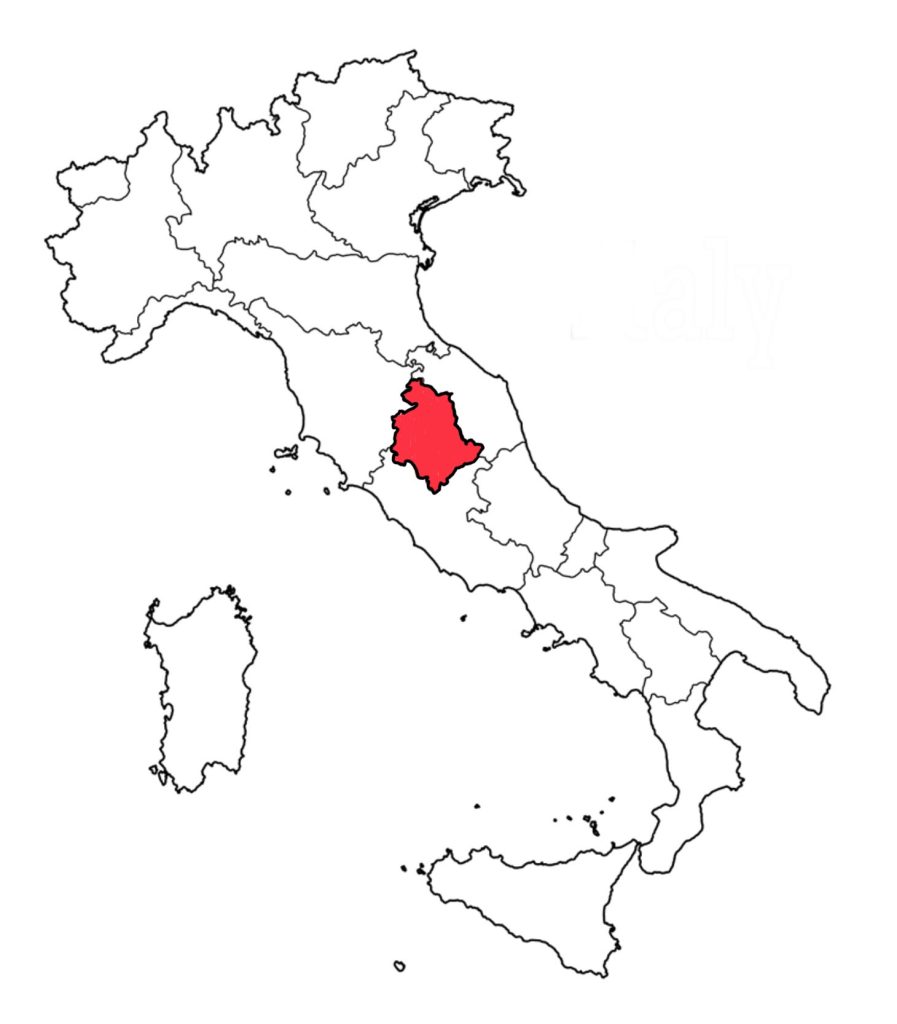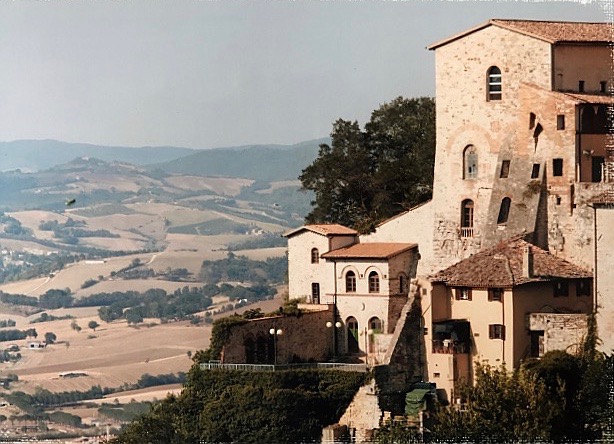Over the Hills and Through the Woods: Umbria and Torre Almonte
It’s September of last year. We board our van/bus “Vito” and leave behind the vigor and verve of Naples. Through the tangle of cars coiling around the tight weave of roads I glance back and catch a last glimpse of the intense blue and sparkle of the coast, a flash of a red building, balconies with arbors wound with vines of grapes and filled with flowering potted plants. The cacophony of sounds of bella Napoli recedes as we quit the city and head north.
I’ve been to Umbria many times before and know it well as one of my closest friends hails from the “green heart of Italy.” Little do my travelling companions know this mid September morning that what we are moving towards is the antithesis of all that we left behind: as we travel northwards towards Umbria the colours of the landscape become muted and hushed; the senses no longer assaulted by the intense and provocative beauty of Naples and its rugged coast, begin to yield to a gentler, verdant landscape lulled by the soothing rise and fall of undulating hills and wildflower-flecked meadows.

The landscape here and there suddenly turns wild and uncultivated with tapering valleys that wrap themselves around jagged mountains. A solemn silence penetrates our space —an imposed quietude, as if the countryside itself would wish us to be restrained and observant of the land around us. There is a mystical aura that permeates. And, no wonder, Umbria is the home of the saints, the birthplace of some of the Church’s holiest of men and women, an area rich in Christian history: St Francis, St Benedict, St Clare, St Rita of Cascia. It makes me wonder if it is the landscape that induces one to prayer and meditation or simply some unknown entity that invades the spirit when entering this land. Mediaeval castles, watchtowers and ancient abbeys can be seen rising above ancient Umbrian towns, crowning the hilltops with sweeping panoramic views over the gentle rolling countryside.

This region of Italy, by its very nature of being landlocked, seems almost remote and timeless. It still today manifests the spirit and aestheticism of the Middle Ages more than any other area of Italy.

http://www.umbria.com/en/umbria/torre-almonte/
A plethora of splendid art and architecture, not to mention its ravishing nature, should make Umbria one of the most exciting travel destinations in Italy. And yet, it remains little known. Towns like Spello, Todi, Montefalco, Norcia, Narni, Amelia, even Perugia, receive little tourism compared to its neighbour, Tuscany. Big tour buses and tourist hordes are simply not to be found in Umbria. And that is certainly a good thing. I discovered this little corner of paradise many years ago through a close high school friend whose family came from Umbria. When the
family moved back here from the States, I came to visit. Piera took me to discover Bevagna, Spello, Collepino, Belfiore di Foligno; Signora Iride, God bless her, introduced me to ,strozzapreti. No one’s, were quite like hers.
Here in this small central region of Italy of hills covered in dark, thick forests of Mediterranean oaks, of silent river valleys and splendid mediaeval towns I found balm for the soul, a feast for the eyes and fulfillment for the palate! I knew then that I had to come back. And I did. Many times.

Today we are headed towards ,Todi: it is near here that we will drop anchor for a week. Along the way we glimpse beautiful ancient villas sitting on well-tended land dotted with cypress trees. Many of these luxuriant homes have been bought up by foreigners who purchase the properties and leave them empty for most of the year. This must certainly change the dynamics of community life, especially since so many younger people have already left the countryside in search of work in big cities elsewhere. Still, the cultivated fields are numerous and tell of productive labour. Vineyards in neat rows on hillsides have brought back the historic vines of the Sagrantino—a grape most readily identified with Umbria. I’m not a wine connoisseur, but the ,Sagrantino di Montefalco is possibly my favourite wine. The anticipation of the succulent Umbrian dinners accompanied by a glass of Sagrantino, makes me heady! Serenity and culinary ecstasy: so glad to be returning to Umbria.
As we climb north from Rome and leave the A1 toward Todi, we find ourselves on steep and sloping country roads that reward us with a tableau of the most uncontaminated and unspoilt countryside.

We are headed toward ,Torre Almonte and an idyllic holiday deep in the Umbrian hills. This is our second visit to this unique and magical residence. Eight years ago we found Torre Almonte by chance. This time we have come intentionally, eager to revisit what had been for us one of our most memorable vacation stays.
The torre, built in the 12th century as a stronghold to protect the city of Todi sits imposingly on top of a small hill gazing over a bucolic park of ferns, olive groves and a 19th century garden of antique specimens of roses.

photo courtesy of http://www.umbria.com/en/umbria/torre-almonte/

We drive up to the gate and then slowly go up the path that takes us to the front portal. We are met by Raffaella Gabetta, the lovely chatelaine of Torre Almonte. Raffaella greets us with open arms and a welcoming gentility that only the well-bred hotelier practices. She remembers us from our last visit 8 years earlier and is happy at our return. Her well-heeled form is preceded by her hospitality as she leads us to one of her beautiful suites and a table laden with torte salate (savoury pies), bread bites topped with truffle spread and of course, prosecco. My travelling companions remain open mouthed at so much elegance and courtesy, not to mention the stunning surroundings.

This splendid mediaeval tower turns into a contemporary
residence on the interior, with sleek designer furnishings and
unique modern art adorning the age-old exposed stone walls. The latest of modern light fixtures illuminate the terracotta floor tiles, and time-weathered wooden doors. But for all the stylish contemporary decor and the careful integration of ultra modern technology, nothing at Torre Almonte compares to the
breathtaking views of the Umbrian countryside seen from the windows of this square tower.

The tower is ours, Raffaella tells us. It is late in the season and so with no other guest here, we are given the choice of two suites and two apartments. All are large, spacious and fabulous. I feel I’ve walked into the pages of Architectural Digest!
We are eager to settle in and explore our temporary abode. A convenient elevator takes us to the rooftop.

We find a lovely awning-covered terrace with lounge chairs and a table for anyone who might consider a moonlit alfresco dinner. All around us is an idyllic park, in the middle of which sits an original 18th century chapel. Immersed in the green of the orchard, sits an inviting pool which still now, at dusk, seems to capture the setting sun.









The long shadows that cut across the countryside now remind us that it has been a long day. We are invited to take breakfast in the morning in Torre Almonte’s large dining room, located on the ground floor of the residence.
Back in our suite, I have the distinct sensation of having traveled through time: despite the lack of long golden braids, I have surely returned as Rapunzel!

I take one last glance outside at the still, sleeping countryside. The feel of the breeze reaching me through the open window, the murmur of the trees, and the rush of some black winged creature, perhaps a falcon, bring me to thoughts of St Francis:
“Praised be You, my Lord, through our Sister Mother Earth, who sustains and governs us…”
from Canticle of the Creatures




